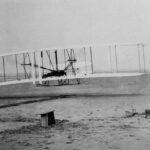Have you ever looked up at an airplane soaring through the sky and wondered, “What makes that massive machine stay airborne?” It’s a question that has intrigued humanity for centuries, and the answer lies in the fascinating world of physics and engineering. Understanding the forces at play is key to grasping the fundamental principles of flight. This exploration into “What Makes Aircraft Fly” will delve into these forces, revealing the science behind how airplanes, helicopters, and even birds take to the skies.
A Boeing 757-300 in flight, illustrating the principles of aircraft flying.
The Engineering Marvel of Flight: More Than Just Magic
It might seem like magic when a multi-ton aircraft defies gravity, but the reality is firmly rooted in scientific principles. Engineers, particularly aeronautical engineers, apply their deep understanding of physics to design flying machines. They meticulously consider the interplay of several forces to ensure controlled and safe flight. From the Wright brothers’ groundbreaking first flight to today’s sophisticated jets, the core principles remain the same. These principles are not just confined to airplanes; they apply to a wide array of flying objects, from wind turbines harnessing the power of air to spacecraft navigating the vastness of space.
The SR-71 Blackbird, a testament to advanced aeronautical engineering for high-altitude flight.
The Four Fundamental Forces of Flight
Aerodynamics, the branch of physics concerned with the movement of air and other gaseous fluids, identifies four primary forces that govern flight. These forces are constantly at work, and their balance and manipulation are what allows aircraft to take off, stay aloft, maneuver, and land. Let’s break down each of these essential forces:
1. Lift: Overcoming Gravity
Lift is the upward force that directly opposes weight, enabling an aircraft to rise and stay in the air. It’s primarily generated by the wings of an airplane and the rotors of a helicopter as they move through the air. The unique shape of an aircraft wing, known as an airfoil, is crucial for generating lift.
2. Weight: The Pull of Gravity
Weight is the force of gravity acting on the aircraft’s mass, pulling it downwards towards the Earth. It’s a constant force that must be overcome by lift for flight to occur. The weight of an aircraft is determined by its mass and the acceleration due to gravity.
3. Thrust: Propelling Forward
Thrust is the force that propels the aircraft forward through the air. It’s typically generated by engines, such as jet engines or propellers. For an aircraft to move forward and generate lift, thrust must overcome drag.
4. Drag: Air Resistance
Drag is the force that opposes the motion of the aircraft through the air. It’s essentially air resistance and is caused by air particles colliding with the aircraft’s surfaces. Factors like the aircraft’s shape, speed, and surface area influence the amount of drag it experiences. Reducing drag is a key consideration in aircraft design to improve fuel efficiency and performance.
Diagram illustrating the four forces acting on an airplane: lift, weight, thrust, and drag.
The Dance of Forces: Balanced and Unbalanced Flight
The motion of an aircraft is determined by the interplay of these four forces. When these forces are balanced, the aircraft maintains a constant state of motion – it can be flying straight and level at a steady speed, or even ascending or descending at a constant rate. This state of equilibrium is crucial for stable flight.
However, when the forces become unbalanced, the aircraft accelerates. Acceleration isn’t just about speeding up; it also includes slowing down or changing direction. For example:
- To speed up: Thrust must be greater than drag.
- To climb higher: Lift must be greater than weight.
- To slow down: Drag must be greater than thrust.
- To descend: Weight must be greater than lift.
Engineers manipulate these forces through various controls on the aircraft, such as adjusting engine power to control thrust, changing the angle of wings and flaps to control lift and drag, and using rudders and elevators to change direction.
The Legacy of Flight: From Wright Brothers to Modern Aviation
The understanding and application of these forces have revolutionized travel and our world. The Wright brothers, pioneers of aviation, meticulously experimented with air tunnels to study these forces, culminating in their historic first controlled flight in 1903. Today, their legacy lives on in the vast network of airports and the millions of flights that occur daily, connecting people and cultures across the globe. Aeronautical engineers continue to push the boundaries of flight, designing ever more efficient, faster, and innovative aircraft, all based on the fundamental principles of “what makes aircraft fly.”
Conclusion: Mastering the Forces to Conquer the Skies
In conclusion, understanding “what makes aircraft fly” boils down to grasping the delicate balance and interaction of lift, weight, thrust, and drag. These four forces are the cornerstones of aerodynamics and aeronautical engineering. By manipulating these forces, engineers have enabled us to conquer the skies, transforming our world and our understanding of what’s possible. The next time you see an aircraft overhead, remember the incredible physics at play and the engineering ingenuity that makes flight a reality.
